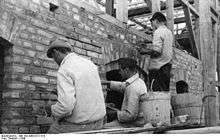Repointing

Repointing is the process of renewing the 'pointing, which is the external part of mortar joints, in masonry construction. Over time, weathering and decay cause voids in the joints between masonry units, usually in bricks, allowing the undesirable entrance of water. Water entering through these voids can cause significant damage through frost weathering and from salt dissolution and deposition. Repointing is also called pointing,[1] or pointing up, although these terms more properly refer to the finishing step in new construction.
Construction details
Bricks, stone blocks, and other masonry units are typically laid in a bed of mortar. The process of placing a masonry unit in a mortar bed causes the mortar to be extruded between units. This excess mortar is cleared and shaped before the mortar hardens. In some cases, the bedding mortar is meant to be seen and the mortar joint is immediately given a finish profile. In other cases, especially where the mortar is pigmented, the bedding mortar is removed from the joint before it hardens (usually a depth that averages about one inch), and then pointing mortar is applied in the void and shaped with a finish profile.
Process
Sound mortar normally does not need to be removed from a building during the repointing process, although such a practice is common. The new mortar should be designed to match the mortar type, color and texture of the existing mortar to avoid incompatible materials and visual aberrations. The professional repointing process begins with a mortar analysis where a sample is taken and examined to identify the components, ratio, and aggregate. The old mortar is removed to a depth equal to or slightly more than the width of the joint, or to the point where sound mortar is reached. Depths greater than 2-1/2 inches or 4cm should be filled in several passes, allowing the mortar to cure for at least 24 hours depending on the mortar type. The joint profile would be as rectangular as possible as the new pointing mortar should be allowed ample opportunity to bond with the masonry unit.
Removal of old mortar between joints is done carefully to avoid damage to masonry units. On buildings with soft materials, such as under-fired brick and lime mortar, removal by hand is often the most effective to avoid damage. Hard Portland cement mortar is usually removed with a grinder or power circular masonry blade, taking care not to damage the masonry units. Vertical joints are done by hand or with small power chisels.
Poor repointing work often raises the level of the mortar joint above the face of the masonry unit, which causes the mortar edge to feather. Such a process is aesthetically undesirable and can cause performance problems as a thin layer of mortar will quickly erode. In addition, depending on the nature of the mortar, mortar that rises above the level of the face of the masonry unit can participate in damaging the arris or corner of the masonry unit. In these cases, deteriorated mortar is often not removed to a sufficient depth.
Materials
It is essential that the mortar used for repointing have similar performance characteristics to the original mortar used in a building. Such performance characteristics include permeability, compressive strength, and coefficient of thermal expansion. For instance, if a soft lime-based mortar was originally used, the most appropriate repointing mortar is likely to also contain a large amount of lime.
An architectural conservator can perform a mortar analysis in order to make recommendations for replacement mortar that is both physically and aesthetically compatible with the building. In the past, lime mortar tended to be mixed on site with whatever sand was locally available. Since the sand influences the colour of the lime mortar, colours of pointing mortar can vary dramatically from district to district.[2]
See also
External links
- http://www.maconline.org/tech/maintenance/point1/point1.html
- Pointing with Lime Article on lime pointing repairs to historic masonry and brickwork
References
- ↑ "pointing, vbl. n 1. " def. 5 Oxford English Dictionary Second Edition on CD-ROM (v. 4.0) © Oxford University Press 2009
- ↑ "Lime Mortar : Haired and Unhaired Putty Lime Mortar". Mike Wye. Retrieved 2016-11-14.
